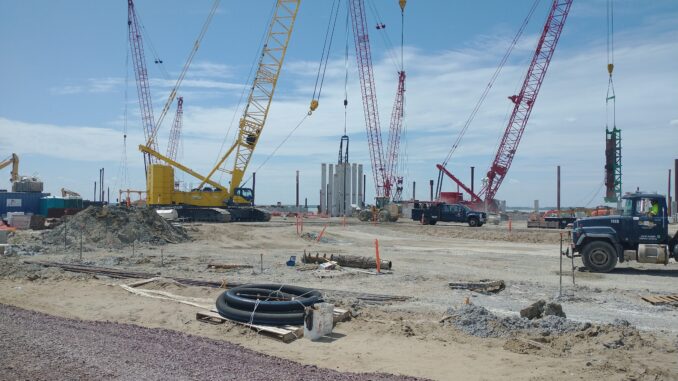
Cross-Posted from Alex’s Substack
_
What’s the final cost to taxpayers and workers when an offshore wind deal goes south?
Mosquitoes were out in force on the Delaware River shore on a sunny day this past August, when I got a look at what was supposed to be the Northeast’s clean energy future.
On a flat and sandy patch of land the size of 30 football fields, in the shadow of a nuclear power plant, workers operated clanking and shuddering crane equipment driving ten-story concrete pilings into the ground.
Soon, officials told me, a stream of ships would be dropping anchor at docks here. The ships would retrieve enormous wind turbines that had been assembled on shore before embarking from the Salem County port to sail south. Free from the obstructions of Philadelphia bridges, the nearly 100-foot high turbine blades would have a clear passage down the river to the Delaware Bay.
Once around Cape May, the ships would head to the Atlantic Ocean, where their turbines would be married with 400-foot high, 40-foot wide steel monopile stems anchored to the ocean floor.
That port was intended to be the linchpin of a government-union-wind industrial complex centered around New Jersey. The project was set to prime the pump for large-scale offshore wind development off the Jersey Shore, establishing New Jersey as a hub for offshore wind and green energy development.
“If you can’t get your first project right, done, it’s hard to imagine getting your third, fourth, you know, tenth project done,” Economic Development Authority CEO Tim Sullivan told me for a story I did while I was reporter for News 12.
But on Halloween night, the offshore wind dreams of Sullivan, Democratic Gov. Phil Murphy, President Biden, union bosses and environmental activists alike imploded in spectacular fashion.
Orsted, the Danish company already signed as a tenant for that facility in Salem County known as the New Jersey Wind Port, pulled out of its commitment to build two massive wind farms 15 miles off the coast of Atlantic City.
Orsted, by the way, is the only current tenant at the Wind Port. They signed a $25 million lease for “up to” two years.
The state’s investment in the Wind Port? Half a billion dollars in taxpayer money.
And that doesn’t include over $250 million more going to a port in Paulsboro 30 miles up the river, an inexplicably separate facility where the monopiles are welded together before they can be floated on barges out to the ocean.
With Orsted now shutting down its two major projects, are facilities being built thanks to hundreds of millions worth of taxpayer dollars worth the cost?
At the Wind Port, another tenant – Atlantic Shores Offshore Wind – has signed on to an upcoming lease agreement, but that lease isn’t set to start until the middle of 2026. Back in September, the Atlantic Shores CEO was already talking about financial challenges for the venture.
“As it stands, we cannot compete for financing and provide continued shareholder investment if we don’t adjust our deal to a changed world,” he told ROI-NJ then. “That’s just the reality. And that’s not a New Jersey issue. That’s not a U.S. issue. That’s a global issue that is plaguing offshore wind and many other industries at the moment.”
If the South Jersey Wind Port and Paulsboro Marine Terminal cannot operate at a profitable capacity to serve the offshore wind farms that are their reason for being, what is their future?
Taxpayers can’t recoup the money that’s already in the ground – literally – in the form of poured concrete, massive pilings and steel rebar in both Salem County and Paulsboro.
There’s no refund for infrastructure that becomes irrelevant.
Elected officials and policy makers need to come to terms with what happens now, after two main projects that were meant to jump-start a governmental-business alliance have ceased to exist.
Offshore wind corporations across the industry were already writing off billions in losses. The Wall Street Journal reported Orsted “previously flagged increasing risks for its projects in the country, citing the lack of favorable progress on tax credits” despite being in line for a billion dollars in federal tax credits thanks to a New Jersey law passed narrowly by the Legislature in June.
Now, Orsted may not get that billion from their attempted bait and switch on ratepayers. The Murphy administration says no wind farm, no deal, and the state law indicates completing the offshore projects is a condition of getting the credits. But you can bet the corporation will contest paying their $100 million performance security – which isn’t due right away, anyhow.
And the $200 million guarantee Orsted forked over into an escrow account? If the state is able to hangs onto that, it’ll easily be written off by the foreign company as just another loss. Governments have no such luxury.
The dream of an offshore wind economy has suffered a serious blow. And taxpayers are now the ones wondering which way the wind is blowing.





